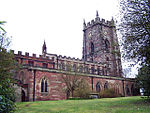Market Drayton Rural District
Districts of England abolished by the Local Government Act 1972Districts of England created by the Local Government Act 1894History of ShropshireLocal government in ShropshireRural districts of England ... and 1 more
Use British English from August 2012
Drayton or Market Drayton was a rural district in Shropshire, England from 1894 to 1974. It was created by the Local Government Act 1894 under the name 'Drayton', from that part of the Market Drayton rural sanitary district which was in Shropshire (the rest forming Blore Heath Rural District in Staffordshire). In 1966 the district was merged with the Market Drayton urban district and renamed the 'Market Drayton' rural district. In 1974, under the Local Government Act 1972 it was abolished, and became part of the North Shropshire district.
Excerpt from the Wikipedia article Market Drayton Rural District (License: CC BY-SA 3.0, Authors).Market Drayton Rural District
The Square,
Geographical coordinates (GPS) Address Nearby Places Show on map
Geographical coordinates (GPS)
| Latitude | Longitude |
|---|---|
| N 52.904 ° | E -2.484 ° |
Address
The Square
The Square
TF9 1QF
England, United Kingdom
Open on Google Maps








